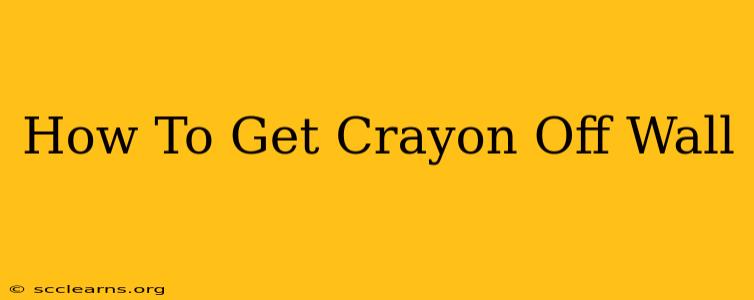Ah, the dreaded crayon marks on the wall. It's a rite of passage for parents of young children, a testament to their boundless creativity (and sometimes, their boundless energy!). But don't despair! Getting crayon off the wall doesn't have to be a Herculean task. This guide offers several effective methods to banish those colorful culprits and restore your walls to their former glory.
Understanding Your Wall's Finish
Before you start scrubbing, it's crucial to identify your wall's finish. Different finishes require different cleaning approaches. Knowing your wall type will prevent accidental damage. Common finishes include:
- Flat: This finish has little to no sheen and is the most delicate. Use gentle methods.
- Eggshell: Slightly more durable than flat, it offers a soft sheen.
- Satin: More durable than eggshell, with a subtle sheen. Slightly more resistant to cleaning solutions.
- Semi-gloss: A durable finish with a noticeable sheen. It can withstand more aggressive cleaning.
- Gloss: The most durable and easiest to clean.
Methods to Remove Crayon from Walls
Here are several methods, ranked from gentlest to most aggressive. Always test any cleaning solution on an inconspicuous area first to ensure it doesn't damage the paint.
1. The Magic Eraser Method (for most finishes)
The humble Magic Eraser is a surprisingly effective crayon remover. Simply dampen the eraser and gently rub the crayon mark. For stubborn marks, you may need to apply slightly more pressure. This method works best on semi-gloss and gloss finishes. Use caution on flat paint as it can be abrasive.
2. Toothpaste Technique (for delicate finishes)
Believe it or not, non-gel white toothpaste can work wonders on crayon marks, especially on delicate finishes like flat or eggshell. Apply a small amount of toothpaste to a soft cloth and gently rub the crayon. Wipe clean with a damp cloth. This method is gentle and less likely to damage your paint.
3. Baking Soda Paste (for stubborn marks)
For more stubborn crayon marks, create a paste of baking soda and water. Apply the paste to the crayon marks and gently scrub with a soft cloth or sponge. Rinse thoroughly with clean water. This is a slightly more abrasive method, so test it in an inconspicuous area first.
4. Hair Dryer and Cloth (for melting crayon)
A hair dryer can soften the crayon, making it easier to remove. Heat the crayon mark with the hair dryer on a low setting, then gently wipe away the softened crayon with a clean cloth. This method is best for larger areas or multiple marks.
5. Isopropyl Alcohol (for tougher stains – use with caution!)
As a last resort, you can try isopropyl alcohol (rubbing alcohol). Dilute it with water (a 50/50 mixture is a good starting point) and apply it to a clean cloth. Gently rub the crayon mark. This method is suitable for semi-gloss and gloss finishes but should be avoided on flat or eggshell paint. Always test in an inconspicuous area first!
Preventing Future Crayon Calamities
- Designated drawing areas: Provide your child with a designated area for drawing, like a table or easel.
- Child-friendly surfaces: Consider using washable markers or crayons on surfaces specifically designed for children's art.
- Regular cleaning: Wipe down walls regularly to prevent crayon marks from becoming deeply embedded.
Conclusion
Getting crayon off the wall doesn't have to be a stressful experience. By following these steps and choosing the appropriate method for your wall type, you can effectively remove crayon marks and keep your home looking its best. Remember to always test any cleaning solution in an inconspicuous area first. Good luck!

